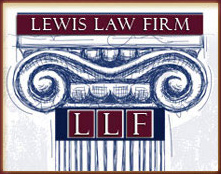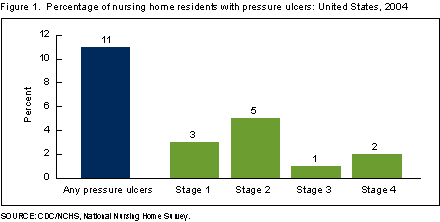Source: U.S. Centers for Disease Control and Prevention
In 2004 a National Survey was conducted of Nursing homes in the U.S. Unfortunately this is the most recent comprehensive study of its type. Among the Data from the National Nursing Home Survey, 2004 was the following:
- In 2004, about 159,000 current U.S. nursing home residents (11%) had pressure ulcers. Stage 2 pressure ulcers were the most common.
- Residents aged 64 years and under were more likely than older residents to have pressure ulcers.
- Residents of nursing homes for a year or less were more likely to have pressure ulcers than those with longer stays.
- One in five nursing home residents with a recent weight loss had pressure ulcers.
- Thirty-five percent of nursing home residents with stage 2 or higher (more severe) pressure ulcers received special wound care services in 2004.
Pressure ulcers, also known as bed sores, pressure sores, or decubitus ulcers, are wounds caused by unrelieved pressure on the skin. They usually develop over bony prominences, such as the elbow, heel, hip, shoulder, back, and back of the head.
Pressure ulcers are serious medical conditions and one of the important measures of the quality of clinical care in nursing homes. From about 2% to 28% of nursing home residents have pressure ulcers. The most common system for staging pressure ulcers classifies them based on the depth of soft tissue damage, ranging from the least severe (stage 1) to the most severe (stage 4). There is persistent redness of skin in stage 1; a loss of partial thickness of skin appearing as an abrasion, blister, or shallow crater in stage 2; a loss of full thickness of skin, presented as a deep crater in stage 3; and a loss of full thickness of skin exposing muscle or bone in stage 4. Clinical practice guidelines for pressure ulcers have been developed and provide specific treatment recommendations for stage 2 or higher pressure ulcers, including proper wound care (5).
More than 1 in 10 nursing home residents had a pressure ulcer.
Of the 1.5 million current U.S. nursing home residents in 2004, about 159,000 (11%) had pressure ulcers of any stage. Stage 2 was the most common (5%), accounting for about 50% of all pressure ulcers. Stages 1, 3, and 4 made up about the other 50% of all ulcers.
Summary:
Overall, 11% of nursing home residents had pressure ulcers in 2004. Various demographic and clinical factors were related to having a pressure ulcer in a nursing home. Residents in a nursing home for a year or less since admission, who had a recent weight loss, or who had high immobility had the highest prevalence of pressure ulcers. Among residents with a pressure ulcer of stage 2 or higher, 35% received special wound care services.
This suggests that a minority of nursing home residents with stage 2 or higher pressure ulcers received wound care in accordance with the clinical practice guidelines. Pressure ulcers are serious and all too common medical conditions in U.S. nursing homes, and remain an important public health problem. Information from this Data Brief on pressure ulcer prevalence and service use among nursing home residents with pressure ulcers may provide a foundation for targeting public health efforts.
~Posted by D.M. Schwadron

